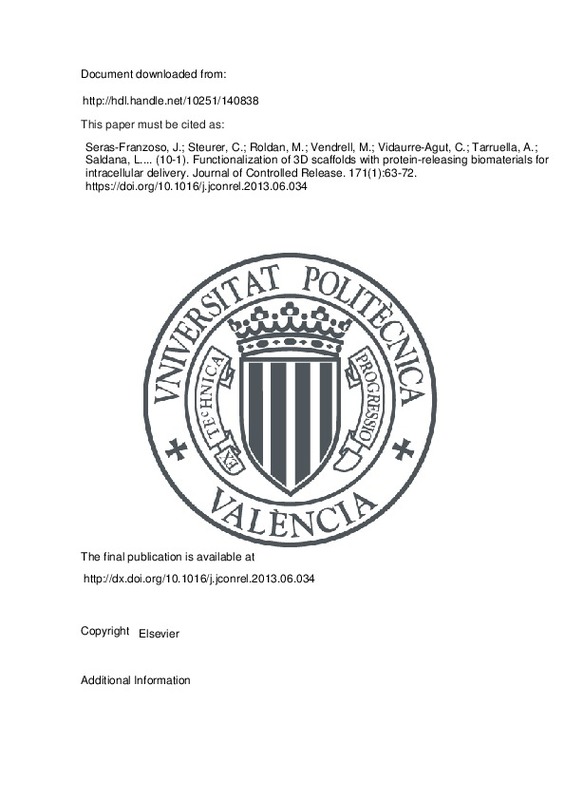Seras-Franzoso, J.; Steurer, C.; Roldan, M.; Vendrell, M.; Vidaurre-Agut, C.; Tarruella, A.; Saldana, L.... (2013). Functionalization of 3D scaffolds with protein-releasing biomaterials for intracellular delivery. Journal of Controlled Release. 171(1):63-72. https://doi.org/10.1016/j.jconrel.2013.06.034
Por favor, use este identificador para citar o enlazar este ítem: http://hdl.handle.net/10251/140838
|
Título:
|
Functionalization of 3D scaffolds with protein-releasing biomaterials for intracellular delivery
|
|
Autor:
|
Seras-Franzoso, Joaquin
Steurer, Christoph
Roldan, Mònica
Vendrell, Meritxell
 Vidaurre-Agut, Carla
Tarruella, Anna
Saldana, Laura
Vilaboa, Nuria
Parera, Marc
Elizondo, Elisa
Ratera, Imma
Ventosa, Nora
Veciana, Jaume
Vidaurre-Agut, Carla
Tarruella, Anna
Saldana, Laura
Vilaboa, Nuria
Parera, Marc
Elizondo, Elisa
Ratera, Imma
Ventosa, Nora
Veciana, Jaume

 CAMPILLO FERNANDEZ, ALBERTO JOSE
García-Fruitós, Elena
Vázquez, Esther
Villaverde, Antonio
CAMPILLO FERNANDEZ, ALBERTO JOSE
García-Fruitós, Elena
Vázquez, Esther
Villaverde, Antonio
|
|
Entidad UPV:
|
Universitat Politècnica de València. Departamento de Termodinámica Aplicada - Departament de Termodinàmica Aplicada
Universitat Politècnica de València. Instituto Universitario Mixto de Tecnología Química - Institut Universitari Mixt de Tecnologia Química
|
|
Fecha difusión:
|
|
|
Resumen:
|
[EN] Appropriate combinations of mechanical and biological stimuli are required to promote proper colonization of substrate materials in regenerative medicine. In this context, 3D scaffolds formed by compatible and ...[+]
[EN] Appropriate combinations of mechanical and biological stimuli are required to promote proper colonization of substrate materials in regenerative medicine. In this context, 3D scaffolds formed by compatible and biodegradable materials are under continuous development in an attempt to mimic the extracellular environment of mammalian cells. We have here explored how novel 3D porous scaffolds constructed by polylactic acid, polycaprolactone or chitosan can be decorated with bacterial inclusion bodies, submicron protein particles formed by releasable functional proteins. A simple dipping-based decoration method tested here specifically favors the penetration of the functional particles deeper than 300 μm from the materials' surface. The functionalized surfaces support the intracellular delivery of biologically active proteins to up to more than 80% of the colonizing cells, a process that is slightly influenced by the chemical nature of the scaffold. The combination of 3D soft scaffolds and protein-based sustained release systems (Bioscaffolds) offers promise in the fabrication of bio-inspired hybrid matrices for multifactorial control of cell proliferation in tissue engineering under complex architectonic setting-ups.
[-]
|
|
Palabras clave:
|
Nanoparticles
,
3D scaffolds
,
Polylactic acid (PLA)
,
Bottom-up delivery
,
Bioscaffold
,
Tissue engineering
|
|
Derechos de uso:
|
Reserva de todos los derechos
|
|
Fuente:
|
Journal of Controlled Release. (issn:
0168-3659
)
|
|
DOI:
|
10.1016/j.jconrel.2013.06.034
|
|
Editorial:
|
Elsevier
|
|
Versión del editor:
|
http://dx.doi.org/10.1016/j.jconrel.2013.06.034
|
|
Código del Proyecto:
|
info:eu-repo/grantAgreement/MICINN//BFU2010-17450/ES/DISEÑO Y PRODUCCION DE PARTICULAS PROTEICAS PARA LA INGENIERIA DE MICRO Y NANO ENTORNOS EN PROLIFERACION CELULAR Y MEDICINA REGENERATIVA/
info:eu-repo/grantAgreement/Generalitat de Catalunya//2009 SGR 0108/
info:eu-repo/grantAgreement/Generalitat de Catalunya//SGR2009-516/
info:eu-repo/grantAgreement/MICINN//CTQ2010-19501/ES/AUTO-ENSAMBLAJE, NANOESTRUCTURACION Y PROCESAMIENTO DE MOLECULAS ORGANICAS FUNCIONALES Y SUS APLICACIONES/
|
|
Agradecimientos:
|
We are indebted to MINECO (BFU2010-17450), AGAUR (2009SGR-0108 and SGR2009-516), DGI (CTQ2010-19501) and CIBER de Bioingenieria, Biomateriales y Nanomedicina (CIBER-BBN, Spain) for funding our research on Inclusion bodies. ...[+]
We are indebted to MINECO (BFU2010-17450), AGAUR (2009SGR-0108 and SGR2009-516), DGI (CTQ2010-19501) and CIBER de Bioingenieria, Biomateriales y Nanomedicina (CIBER-BBN, Spain) for funding our research on Inclusion bodies. CIBER-BBN is an initiative funded by the VI National R&D&i Plan 2008-2011, and Iniciativa Ingenio 2010, Consolider Program, CIBER Actions and financed by the Instituto de Salud Carlos III with assistance from the European Regional Development Fund. EGF is supported by the Programa Personal de Tecnico de Apoyo (Modalidad Infraestructuras cientifico-tecnologicas, MICINN). We also thank technical assistance from the Servei de Cultius Celulars, Produccio d'Anticossos i Citometria (SCAC) Laboratori de Luminescencia i Espectroscopia de Biomolecules (LLEB) and Servei de Microscopia, all at the Universitat Autonoma de Barcelona (UAB). We are also indebted to the Protein Production Platform (CIBER-BBN) for helpful technical assistance and for protein production and purification services (http://bbn.ciber-bbn.es/programas/plataformas/equipamiento). AV received an ICREA ACADEMIA award.
[-]
|
|
Tipo:
|
Artículo
|







![[Cerrado]](/themes/UPV/images/candado.png)


